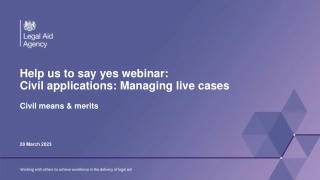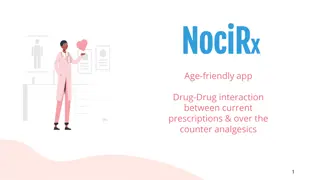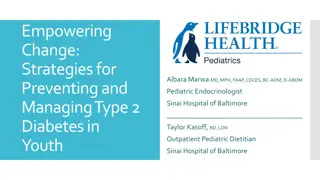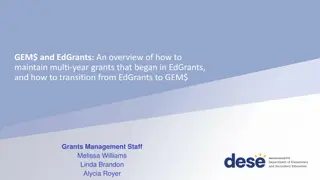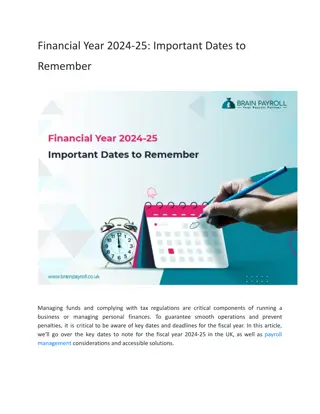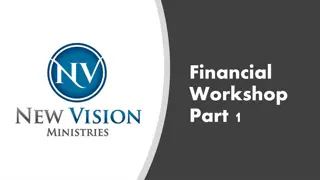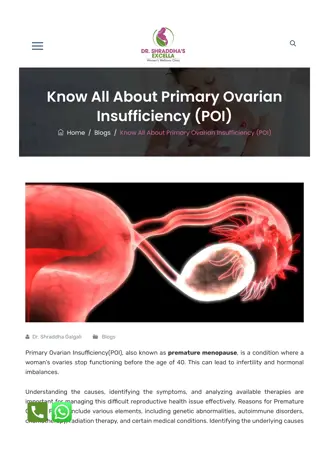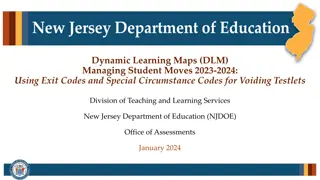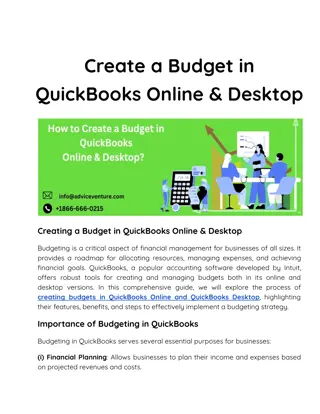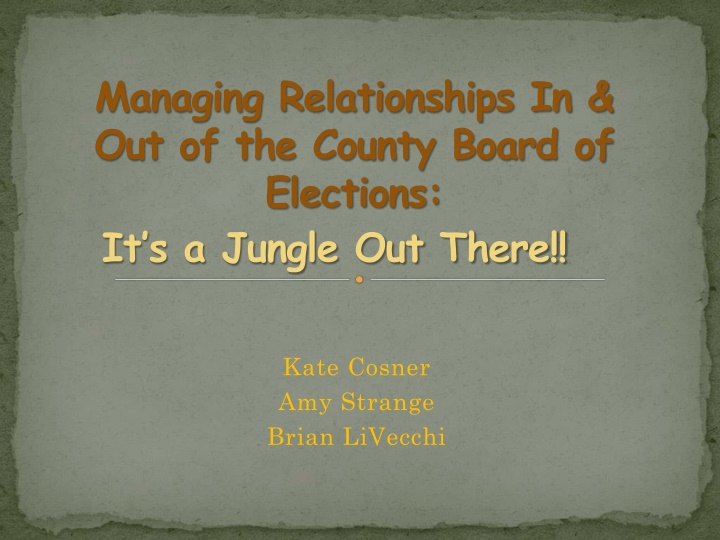
Building Positive Relationships in the County Election Board
Learn the importance of maintaining good relationships with key stakeholders in the County Board of Elections, including county administration, candidates, media, and staff. Discover how respect, diversity, communication, and trust are essential for fostering a positive work environment and promoting creativity.
Download Presentation

Please find below an Image/Link to download the presentation.
The content on the website is provided AS IS for your information and personal use only. It may not be sold, licensed, or shared on other websites without obtaining consent from the author. If you encounter any issues during the download, it is possible that the publisher has removed the file from their server.
You are allowed to download the files provided on this website for personal or commercial use, subject to the condition that they are used lawfully. All files are the property of their respective owners.
The content on the website is provided AS IS for your information and personal use only. It may not be sold, licensed, or shared on other websites without obtaining consent from the author.
E N D
Presentation Transcript
Managing Relationships In & Out of the County Board of Elections: It s a Jungle Out There!! Kate Cosner Amy Strange Brian LiVecchi
Whos Relationship is Important? EVERYONE!!!!!!! County Administration County Parties Candidates Media Staff Board Members & Director Fellow County Boards of Elections State Board of Election
Why Have a Good Relationship? Good working relationships promote positive work environments. Human beings are social creatures We CRAVE positive feedback and friendly interactions!!! Good relationships foster creativity. Good relationships provide freedom. No spending time you don t have fixing problems that come from a negative work environment! Opportunities are born.
4 Characteristics to Build a Good Working Relationship Respect Welcome Diversity Communication Trust
RESPECT When you respect each other s work, you show that you value each other s contribution, input & ideas. With respect, you can work together as a team. Respect increases creativity, insight & wisdom.
An Approach to Workplace Respect Give those responsible appropriate information. Encourage feedback from staff and precinct officials. Encourage creativity and continuous improvement. Develop a mindset among all staff that there is always a better way. Be a role model and encourage a positive attitude. Attitude, Attitude, Attitude!
Treat People with Integrity, Respect and Empathy Be sensitive to the needs of others Communicate openly and honestly Be reliable Be loyal to the Board and workers Be self motivated Be collaborative Treat people equitably Be concerned about people s welfare Consult with employees Appreciate individual differences Plan tasks well
WELCOMING DIVERSITY Diversity - the quality of being different and unique at an individual or group level. Valuing diversity - appreciating and respecting the worth and contribution of human differences. Managing diversity - creating and sustaining an open, supportive, responsive organisation in which differences are combined and encouraged so that everyone can reach their potential.
DIVERSITY fuels creative energy and insight is essential to the growth of individuals sparks alternative viewpoints and ideas enables organisations to develop broad perspectives, pre-empt change and approach problems creatively
Welcoming Diversity: Individual Differences Perceptions Motivation Gender Self-esteem Life Stage Values and Attitudes Locus of Control Education and Skills Preferences Socio-cultural Career Goals Expectations Position roles
Welcoming Diversity: The Legal Framework The Legal Framework Remember, there is state and federal legislation prohibiting discrimination and harassment on the grounds of: Race and Nationality Transgender Gender Religion Age Partners characteristics Sexual preference Pregnancy Disability Family responsibility Marital status
Managing Workplace Personalities Recognize that occasional workplace problems will occur. Common problems include conflicts, stereotyping, rivalries. More difficult problems include harassment, bullying and violence. It is important to use conflict resolution skills to work out conflicts when possible. Avoid thinking in terms of stereotypes. Treat people as individuals rather than as part of a group.
Attitudes versus Emotions Attitudes Emotions Judgments about an attitude object Experiences related to an attitude object Based mainly on rational logic Based on innate and learned responses to environment Usually stable for days or longer Usually experienced for seconds or less
Listening promotes being heard Seek first to understand, then be understood. - Stephen Covey
Listening is the most powerful form of acknowledgment a way of saying, you are important.
Barriers to Listening Equate With Hearing Uninteresting Topics Speaker s Delivery External Distractions Mentally Preparing Response Listening for Facts Personal Concerns Personal Bias Language/Culture Differences Faking Attention
Did you know? we listen at 125-250 wpm, think at 1000- 3000 wpm. 75% of the time we are distracted, preoccupied or forgetful 20% of the time, we remember what we hear more than 35% of businesses think listening is a top skill for success less than 2% of people have had formal education with listening
BENEFITS OF ACTIVE LISTENING It forces people to listen attentively to others. It tends to open people up, to get them to say more. It shows empathy. It uilds relationships.
KEY CONCEPTS OF ACTIVE LISTENING 1. Display involvement in what the person is saying. 2. Carefully observe the person speaking. 3. Try to stay focused on what is being said. 4. Ask for clarification of anything that you do not fully understand . 5. Delay making judgments about what is said.
Internal Barriers Within the Listener Comparing Personal Experience Automatic Talking Mind-Reading Judging Day Dreaming Perceptual Errors
STEPS OF ACTIVE LISTENING 1) Listen 2) Question 3) Reflect-Paraphrase 4) Agree
Step 1: Listen Hear Feelings As Well As Words Words Emotions -- Implications Focus on Speaker Don t plan, speak, or get distracted What Is Speaker Talking About? Topic? Speaker? Listener? Others? Look At Speaker! Use Verbal & Non-Verbal Encouragers
Step 2: Question 3 Purposes Demonstrate you are listening Gather information Seek Clarification When you ask questions: Show interest Encourage more explanation Keep the person talking Ask questions but not too many
Step 3: Reflect-Paraphrase In this step we will use other techniques for active listening: Reflecting Reframing Paraphrasing Acknowleding Summarizing 1. 2. 3. 4. 5.
Act like a mirror and reflect feelings that you see and hear. This is particularly useful when the person s tone of voice or gestures don t match the person s words. OR just as a check Seems like you had a fun time, right? OR I sense you ve become worried. Is that so?
ACKNOWLEDGE Problem Solving Might Not Work In the Face of Strong Feelings Problem Solving Feelings May Need Acknowledgement Before Effective Problem Solving Problem Solving
Step 4: Agree Get Speaker s Consent to Your Reframing Speaker Has Been Heard and Knows It! Solution Is Near!
A understand thoroughly what the other person is saying. In the end he may disagree sharply, but before he disagrees, he wants to know exactly what it is he is disagreeing with. Kenneth A. Wells good listener tries to
ACTIVE LISTENERS Be there. Listen carefully to the person. Accept the person and his/her feelings. Stay with the other person's point of view without becoming that person. Trust the person enough to keep out of it. 1. 2. 3. 4. 5.
Skills for Active Listening BODY LANGUAGE Examples: Sitting forward Eye contact Nodding head
BOUNDARIES Intimate Touching 6-18 Personal Close -1 to 2 feet Far - 2 to 4 feet Social Close 4-7 feet Far - 7-12 feet Public Close - 12-25 feet Far - 25 feet or greater
When you invade my space. . . Reactions to an invasion of your space Feel troubled Get defensive Become aggressive Retaliate
TRUST Foundation of EVERY relationship When present, forms a powerful bond that helps you communicate more effectively Must be able to trust those you work with: Board Director Director Staff CBE SBE CBE County (candidates, parties, administration) Without it, precious energy is spent watching your back
Develop Trust and Confidence TRUST can be defined as confidence, the absence of suspicion, confirmed by our track record and our ability to correct. People with a great deal of CONFIDENCE feel good about themselves and think that they are able to accomplish most tasks that confront them.
Develop Trust and Confidence Treat people with integrity, respect and empathy. Develop and maintain positive relationships. Gain and maintain trust and confidence. Adjust interpersonal styles to the social and cultural environment.
Actions a Leader can Take to Gain and Maintain Trust and Confidence solve problems share credit air concerns with relevant people hold informal talks be direct in communication be timely and admit mistakes engage in honest and tactful communication schedule regular meetings for input and feedback
Summary Workplace relationships differ from friendships in several ways. Do your part, work cooperatively, and communicate clearly to foster good relationships with your coworkers. Workplace etiquette is a matter of being respectful and considerate. To get along with your supervisor, you need to accept authority, take initiative, and respond appropriately to criticism.



